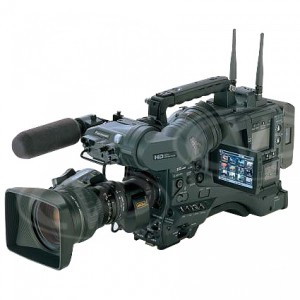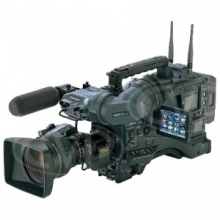
SECAUCUS, NJ (July 28, 2008) – “Saturday Night Live,” NBC’s Emmy winning late-night comedy show, has launched the careers of many of the country’s biggest comedy performers. Since the inception of the SNL Digital Shorts during the 2005-2006 season, John Rosenblatt of Rosey Media has served as the Director of Photography of the segments, which are consistent crowd-pleasers and some of the most “viral” video shared on the Internet. Beginning last February (the end of the writers’ strike), the DP has been shooting the shorts with Panasonic’s AJ-HPX3000 native 1080p one-piece P2 HD camcorders.
Rosenblatt previously shot with CineAlta cameras, but chose the HPX3000 based on the camera’s filmic image quality and solid-state workflow.
“The HPX3000 is a great fit for the Digital Shorts,” Rosenblatt said. “The P2 workflow works well with the Final Cut Pro-based system the show uses to post. We shoot the shorts in 1080/24p (vs. the rest of the show which is shot in 1080i), and we like the cine-like look and feel. Also, the camera’s four-channel audio is crucial as we isolate each audio track.”
Rosenblatt rents HPX3000 camera packages from Liman Video Rental Co. (LVR) in New York City. LVR sets the cameras up with Anton Bauer Dionic 90 Batteries and P2 Stores or FireWire drives as needed.
“I normally work with one or two cameras depending on what we are shooting, how much time we have, and the style the writers are looking for,” he explained. “We normally get involved after the writers’ meeting ends around 9 p.m. on the Wednesday evening before that week’s show. Later that night, I get the details on what we will be shooting. Although we have the team and equipment ready to go, it is not uncommon to get a request for a Steadicam, second camera or other gear late Wednesday. We have only Thursday and Friday to coordinate and shoot, as the finished work needs to be edited, mixed and ready for air by the 8 o’clock dress rehearsal Saturday night.
“We shoot a bit in the studios at 30 Rock, then on location depending on what the script requires. We shoot a lot around Rockefeller Center. Some of the show’s writers and cast live in the West Village and like to shoot around there. Manhattan’s Lower West Side as a whole is quiet and close to the studio, so we can take a big star around there without people overreacting as much.”
“The HPX3000 takes great pictures straight out of the box,” Rosenblatt continued. “The chips look great in low light even when gained up three to six times, with next to no distortion. When setting up a shot, I like to look on a monitor with the camera in pre-set white balance first before playing with the color matrix. I like to crush blacks a bit, but otherwise I have not needed to mess with the gamma that much in order to make great compositions. The camera is hugely versatile without being complicated to set up.”
Rosenblatt is currently shooting using the DVCPRO HD format. (Final Cut Pro now offers AVC-Intra compatibility and SNL plans to transition to the AVC-Intra format later this year for the fall season.)
“I normally use Fuji glass (e.g., the HAs18*7BRM18 HD lens) and always have a Fuji 13*4.5BERM wide angle, sometimes with a matte box if needed,” he said. “I use Panasonic’s BT-LH900E LCD HD monitor and a glass monitor if possible. Audio is hard wired from the audio engineer to the camera unless it’s in a Steadicam.”
Rosenblatt shoots with 32GB P2 cards.” We usually change out cards when they are about 25 minutes full so they can be imported into Final Cut and placed in bins for quick editing,” he explained. “We use the five-card AJ-PCD20P P2 reader into a Mac-based Final Cut Pro. If I am on location I will bring at least five 32GB cards, sometimes a P2 Store if needed.”
Rosey Media also recently used two HPX3000s to shoot a series of agency spots for Sally Hansen Cosmetics. “This camera is perfect for commercial shoots. The ad agency folks love the ‘filmy’ texture of the video,” Rosenblatt noted. “On commercial sets we have a portable Final Cut Pro and take the P2 cards from the camera and import them directly into FCP. An assistant editor organizes the bins so we can show the client a rough cut of the spot while still on set. How cool is that?”
“The HPX3000 is the best cine-like video camera I have used: it’s less expensive than the competition and offers a great 24p look,” Rosenblatt said. “The camera allows you to capture outstanding HD images, and it enables a native 24p workflow which has not been possible until now. What’s more, no more broken tapes and clogged video heads, heck, no more tape… which I say is a good thing.”

